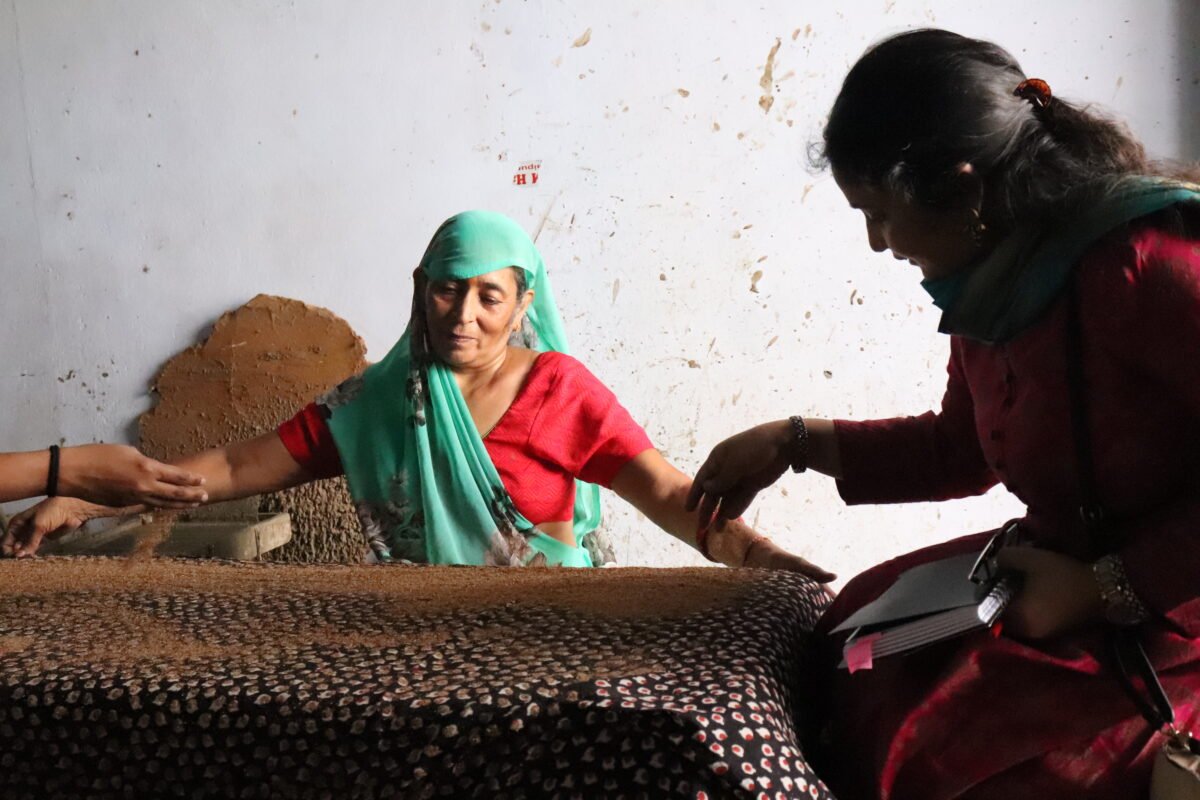Blog
Discover the Beauty & Heritage of Dabu Printing: A Guide to this Timeless Art Form
| Feature | Description |
| Craft | Dabu printing |
| Printing Method | Handblock printing using wooden blocks |
| Origin | Rajasthan, India |
| Design | Floral and geometric motifs inspired by nature |
| Color | Earthy and muted tones, natural dyes used |
| Material | Cotton, silk, and other natural fabrics |
| Characteristics | Soft and absorbent, resist dyeing technique results in unique textures and patterns |
| Popular Use | Sarees, dress material, home textiles |
Known for its rustic charm and intricate designs, Dabu printing is a mud-resist technique used to print fabric mostly in earthy tones. The verb “dabaana” which means to press, is where the name Dabu (or Dabboo) comes from. It is one of the most intriguing artisanal crafts that has been practiced in India for centuries, particularly in the districts of Rajasthan. The majority of practitioners of this craft are located in the Rajasthani cities of Akola, Udaipur, and Bagru. The art of dabu printing has a rich history and is passed down from one generation to the next.
One of the most significant aspects of Dabu printing is its eco-friendly nature. Unlike other printing techniques, Dabu printing does not use any chemical or mechanical processes. The entire process has an extremely low carbon footprint because the dyes used in printing are naturally sourced from plants and minerals.



Why Rajasthan?
The origins of Dabu printing
There are different techniques of hand block printing across the world. However, Dabu is a unique one known to have originated in the 16th century in the Indian state of Rajasthan. Rajasthan’s rich cultural heritage and tradition of textile arts made it an ideal location for the practice of Dabu printing.
- The state has a long history of textile production, including hand block printing, and is home to a large number of skilled artisans who are proficient in the technique.
- The raw materials used in the process like clay, gum, and pigments are also readily available in the region, making it an ideal location for the craft.
- The climate in Rajasthan is well-suited to the preservation and production of the materials and processes used in Dabu hand-block printing. The arid climate help to preserve the natural dyes used in the process. The clay and gum used in the process work best in dry weather as they are easy to prepare and apply in dry conditions. The region’s heat and low humidity help dry the printed fabric quickly and thoroughly, preventing smudging and ensuring that the prints are long-lasting and vibrant. The dry climate also prevents mold and mildew from growing on the fabric, which can damage the print or cause discoloration.



The Art of Dabu printing
Technique and Process
In the Dabu printing process, wooden blocks that have been intricately hand-carved are used to apply a mud paste made of Kali Mitti, Chuna, Gur, and Gond onto the fabric. In order to prevent pattern smudging when the dabu print is wet, sawdust is sprinkled over it. The mud makes the printed region resistant to dyes. The fabric is then left in the sun to dry thoroughly. Once it is dry, it is immersed in a vat of natural dye (indigo for blue, natural iron deposits for grey or brown, and pomegranate and alum for red) and then dried and washed again to remove any mud stains, revealing the original white color of the resist areas.
This process is repeated if necessary, resulting in double or triple dabu printing techniques, which are more complicated and detailed. The motifs used in Dabu printing are typically inspired by elements of nature, such as peacocks, foliage, cornstalks, sunflowers, mangoes, other animals, and bird designs. Dabu printing is a labor-intensive craft that requires multiple washings and printings at different stages


Dabu prints – the most sought-after prints in the global market
Dabu prints are one of the most sought-after prints in the global market for a variety of reasons. Their cultural significance, unique aesthetic appeal, eco-friendly nature, and durability make them highly valued by art lovers and consumers who appreciate traditional techniques, beautiful designs, and sustainable production.
The intricate motifs and vegetable-based coloring make it a desirable print in the global market. During the 19th century, Dabu printing gained popularity as a decorative art form and was even exported to Europe, where it was known as “Indienne printing”. Initially, dabu printing was only done on fine cotton, but it is now also being done on other fabrics such as silk, georgette crepe, and chiffon in order to cater to a wider market. Dabu print is seen as a symbol of Indian heritage and the demand for it is expected to continue to grow, particularly in the European market.
In a world that is increasingly focused on sustainability, India’s knowledge of natural dyes and dyeing techniques is becoming more valuable. Many brands are positioning themselves as sustainable producers in response to this trend. Mooldhaga.com is one such initiative in this direction.
Challenges and way forward
Despite a deeply rooted history, just a handful of artisan exists now to carry on this age-old tradition. The technique is on the verge of extinction in its pure form due to
- Mechanization and use of chemical dyes: This has made it difficult for artisans to compete with cheaper, chemically dyed, and machine-made products in the market.
- Lack of adequate incentives for the skills: The traditional skills involved in hand block printing is passed down through generations and are becoming increasingly rare, making it difficult for artisans to find skilled labor to assist them.
- Lack of awareness among customers: Many customers are unaware of the value and uniqueness of natural hand-block printed textiles, which can make it difficult for artisans to sell their products at a fair price.
- Difficulty in sourcing raw materials: Obtaining the natural dyes, pigments, and other raw materials used in natural hand block printing can be difficult and expensive for artisans.
- Lack of adequate support: Artisans often do not receive sufficient support from the government, NGOs, and associations in terms of training, marketing assistance, and access to credit, to help them overcome these challenges.
Reviving tradition
The resurgence of Dabu printing in modern fashion
To prevent the craft from disappearing and to support the livelihoods of artisans who have relied on it for centuries, there must be efforts to upskill and develop entrepreneurship support structures.
This can be done by organizing exhibitions and workshops to showcase the traditional technique, and by involving the local communities in the preservation of their traditional technique.
In addition, the government and non-government organizations can provide financial and technical support to the artisans and craftspersons in order to modernize the production methods and promote the traditional technique on a larger scale.
The use of natural dyes and eco-friendly production methods in Dabu printing should be revived through appropriate interventions to align the craft with the current trend of sustainability and eco-consciousness. This can help to attract a new generation of customers who are looking for sustainable and ethically-produced products.

